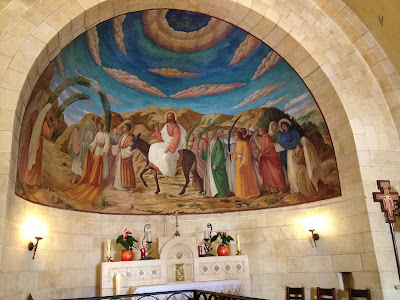I had THE BEST time I've ever had here in Jerusalem this week, I didn't want it to end! What a bitter-sweet week knowing we had to leave soon... but it was so special visiting the sacred sites that made such an impression for our life today.
For our last field trip we went through the sites Christ did during His last week in Jerusalem before He was crucified.
For our last field trip we went through the sites Christ did during His last week in Jerusalem before He was crucified.
BETHANY
Where Jesus raised Lazarus from the dead
I am standing at the entrance, sorry I guess I'm blocking it from view too!
BETHPHAGE
Bethphage (Hebrew meaning "house of unripe figs") is a small village on the Mount of Olives and close to Bethany, where we traditionally believe Jesus began his Triumphal Entry into Jerusalem.
This picture is inside the Catholic chapel at Bethpage.
After Jesus walked from Bethany to Jerusalem, he told his disciples to loose the donkey tied at a nearby village and bring it to him (Matthew 21:1-2).
The entrance to the Bethphage church.
Pater Noster Church
(back angle)
Located at the top of the Mt. of Olives, along the ancient footpath and modern road from Bethphage to Gethsemane.
This church is associated with Jesus teaching His Apostles during His last week, and with His Ascension into heaven (declared by Constantine's mother, Helena).
Later it became associated with the giving of the Lord's Prayer (by local tradition after the Crusaders replaced it in the 12th century), because Latin, Greek, and Hebrew inscriptions of it were found in the ruins of the 4th century church.
Today it's the 19th century complex continuing the "Pater Noster" tradition.
Pater Noster is Latin for "Our Father," the first phrase of the Lord's Prayer.
All over this church is versions of the Lord's Prayer in over 60 languages! It was special to see the excitement of all the students who have mission calls find the language they will be teaching in; faces lit up with wonder as they tried to pronounce this foreign scripture, but knowing it all meant the same thing. I felt a connection to Spanish because of my grandparents, I still want to learn how to speak it!
How neat is it that the Gospel is the same regardless of where we are? It might sound different, but God is the same yesterday, today, and forever (1 Nephi 10:18-19; 2 Nephi 29:9).
Walking away from the Pater Noster.
View of the Old City and grave sites along our walk Jesus would have gone down during his Triumphal Entry.
Dominus Flevit Church
Latin for "the Lord wept,"
commemorating when the Lord wept over Jerusalem in Luke 19:41
This church was built in 1955 and is shaped like a teardrop to remember the tears of the Savior.
Dome of the Rock and the Old City taken from the overlook of Dominus Flevit Church
Being here where Christ wept over Jerusalem made me never want Christ to weep over me.
Loved ones in a Sacred place
When Christ pondered and wept over Jerusaelm, I imagine the image looked something like this.
Matthew 23:37
"O Jerusalem, thou that killest the prophet, and stonest them which are sent unto thee, how oft would I have gathered thy children together, even as a hen gathereth her chickens under her wings, and ye would not!"
The walk to each place is enchanting.
The Upper Room
Dormition Abbey
Church of St. Peter in Gallicantu
Commemorating both the trial of Jesus by the High Priest Caiaphas (Matthew 26) and Peter's denial of the Savior three times.
Gallicantu comes from the Latin words gallus, meaning "rooster" and cantu, from the verb "to crow."
Gallicantu means the "rooster's crow," (Matthew 26:74).
Where the Savior walked.
These stairs date to the Herodian Period.
If this is the correct site of Caiaphas' palace, then Jesus may have walked on these very steps on his way to the Sandhedrin trail.
Matthew 26:75
"And Peter remembered the word of Jesus... Before the cock crow, thou shalt deny me thrice. And he went out, and wept bitterly."
This is a picture of the real archaeological remains of cellars below where the church was built. Jesus would have been held in an underground dungeon like this very one.
Matthew 26:57-58
This beautiful Catholic Church was built around 1930.
The Byzantine church built on this site was built in the 5th century AD

























No comments:
Post a Comment